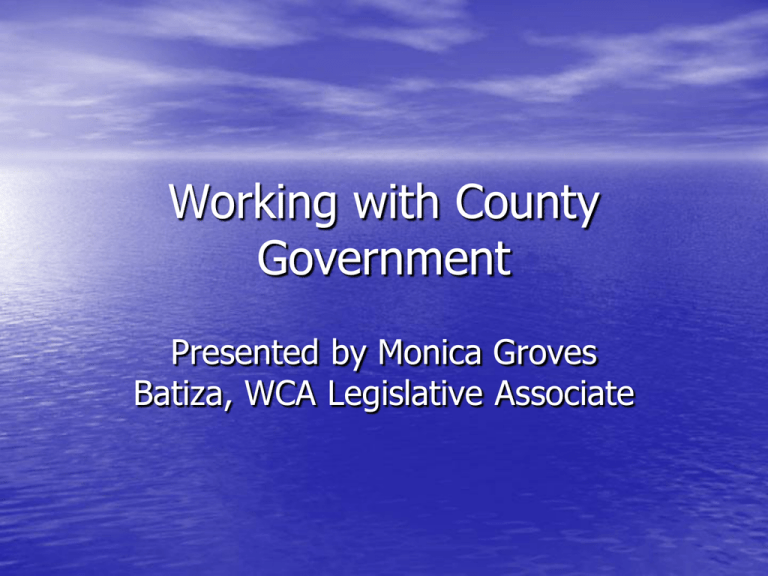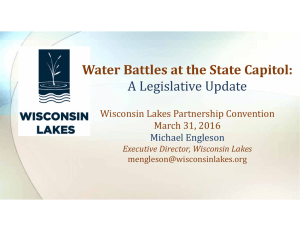Working with County Government Presented by Monica Groves Batiza, WCA Legislative Associate
advertisement

Working with County Government Presented by Monica Groves Batiza, WCA Legislative Associate Wisconsin State Legislature • Of the 99 Assembly representatives, 52 • are Republican and 47 are Democrat There are currently 11 Assembly seats being vacated by legislative retirees. Of the group: – Six Republicans – Five Democrats Wisconsin State Legislature cont. • The Senate is comprised of 33 districts. Democrats hold the majority with 18 seats, while Republicans hold 15 seats • There are currently two seats being vacated by legislative retirees. Of the group: – One Republican – One Democrat (Senator Roger Breske, outgoing Chair of the Senate Committee on Transportation and Rails) A Brief Overview of County Government • There are 72 counties in Wisconsin • The main function of county government • is to serve as the administrative arm of state government Counties do not have constitutional home rule authority like cities and villages – This means that counties can only undertake a function that is expressly allowed for or mandated by state statute or the Constitution A Brief Overview of County Government cont. • It is up to the individual county board of • supervisors to determine how to use the powers delegated by the Legislature Although all counties are mandated by the State to provide essential services such as human services, courts and law enforcement, there is a great deal of variation between counties in terms of land use regulations and programs County Budget Process • County revenues are derived from property taxes, state aids, and permits/fees/fines • Impact of potential state aid cuts include: – – – – – – Growth in equalized value will be limited Attempts to increase long term borrowing Efforts to raise user fees, charges and fines Optional sales tax Cuts in personnel and fringe benefits Efforts to cut discretionary programs Shoreland Zoning • All counties, with the exception of • Milwaukee and Menominee Counties, are required by statute and administrative rule to have shoreland zoning ordinances NR 115 sets shoreland protection program minimum standards. Counties DO have the authority to exceed the minimum standards created by NR 115 NR 115 • The DNR is in the process of re-writing NR 115. After many years, a new draft of the rule is in its final stages of revision • If the Natural Resources Board approves the proposed changes, NR 115 will be sent to the Legislature for review and possible modifications • Once passed into law, counties will have two years to bring their shoreland ordinances into compliance and begin requiring property owners to follow the revised standards County Concerns with NR 115 • The overarching issue of concern to • counties is implementation of the new rules Counties need a greater commitment from the State to successfully implement the shoreland program and protect our water resources Differing Approaches to General Zoning • Just as counties have the flexibility to exceed minimum standards for shoreland zoning, they also have flexibility in regard to general zoning • While some counties have a general zoning ordinance, other counties operate without any zoning • Towns may or may not assume the role of providing general zoning in counties without a zoning ordinance in place Invasive Species • Both terrestrial and aquatic invasive species are increasingly becoming a problem throughout Wisconsin • Invasive species can alter ecological relationships among native species and can affect the function of ecosystems, economic value of ecosystems, and human health • WCA seeks increased funding to state and county efforts which attempt to combat invasive species Invasive Species cont. • WCA has partnered with Discover Mediaworks to increase public awareness of this daunting problem • A DVD entitled “Stopping Aquatic Hitchhikers” was produced by the “Invasive Species Education Alliance,” a consortium of public, private and educational groups dedicated to promoting public awareness of the magnitude of the threat of invasive species • These groups include WCA, Discover Mediaworks, the Bureau of Indian Affairs, the Great Lakes Indian Fish and Wildlife Commission, the Lac du Flambeau Band of Chippewa Indians, the Wisconsin Departments of Tourism and Natural Resources, and the University of Wisconsin-Extension Great Lakes Compact • A set of rules the eight Great Lakes states have committed to in order to keep communities outside the region from tapping into the lakes • Senate Bill 523 finally passed the Legislature after the Governor called a “Special Session” to bring legislators back to work out a compromise • Issue of concern was the ability for any Great Lakes governor to have veto authority over another state’s diversion application for communities (City of Waukesha is an example) that lie entirely ouside of the basin Great Lakes Compact cont. • Compromise was reached to alleviate concerns of communities outside of the basin • The U.S. Senate ratified the compact in August 2008, followed by the House of Representatives in September • President Bush signed the Great Lakes Compact into law on October 3, 2008 • The two Canadian provinces that border the Great Lakes have signed a parallel agreement Working with County Officials • Get to know the role your respective • municipality and county plays in land use regulations Determine which department is responsible for providing the service or enforcing the ordinance of interest to you – This would likely be the County Planning and Zoning Department and/or the County Land and Water Conservation Department Working with County Officials cont. • Get to know the committee members of the committee that is responsible for overseeing the operations of the department and get to know the staff of said department • Whenever possible, attend committee meetings. Be aware of the issues in front of the local government officials and determine how the issue may directly impact you – This is especially true in comprehensive planning where community input is an integral component of a successful plan Working with County Officials cont. • Maintain an open dialogue with your respective locally elected official – Citizen participation in local government gives elected officials a deeper understanding of the differences that may exist in the community





